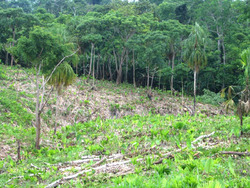Community Forestry Management, Indigenous Peoples, and REDD
/I recently visited the community of Ixtpal de Juarez, an indigenous community in the Sierra Norte of Oaxaca, Mexico. The 19,000 hectares of forest that the community manages generates almost $2 million/year in revenue and more employment than the community can fill.
The heart of this operation is a forestry management unit that uses sustainable practices on the 3600 hectares. This timberland supplies their saw mill enough logs to produce 25,000 cubic meters of sawn lumber per year. While the lumber could be sold on the market for ~$1/ board foot, it is instead transformed into furniture that sells for the equivalent of $3/board foot.
The project started almost 25 years ago when the community took control of the timber concession previously managed by a private timber company.




